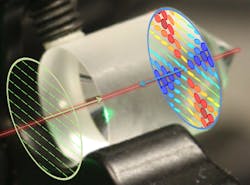University of Glasgow physicists make less-expensive radially polarized beams
University of Glasgow (Glasgow, Scotland) physicists Neal Radwell and Sonja Franke-Arnold have discovered a new way of producing radially polarized beams using broadband white light (rather than single-frequency beams) by reflecting the light from a glass cone. If white light with a uniform polarization across the whole beam is reflected back from a small glass cone, the light becomes an optical vortex, for example, with polarization always pointing to the center. Such light can be focused on a much smaller scale than was previously thought possible.
RELATED ARTICLE: Radial-polarization interferometer tops Michelson capabilities
The breakthrough could be useful in microscopy, as it enables scientists to record images with a much better resolution, and also in astronomy, where so-called vortex coronagraphs can be used to see faint objects from light years away that are normally obscured by near very bright stars.
Radwell, lead author on the report entitled "Achromatic vector vortex beams from a glass cone," published in Nature Communications, said, "Scientists can make these kind of beams already but we have found the first way of making radial polarisation using white light—light that contains all different colours—rather than lasers and light of a very particular frequency. What we have proved is not that you can focus these beams better, that has been shown before, but we have found a new way to make those beams."
Franke-Arnold, who devised the glass cone technology, said, "What is incredible to us is that such interesting physics has come from something so simple. Previously people have been using nano-fabricated devices, which are extremely expensive, but we have come up with a new mechanism to create polarisation structures which could be really useful for future applications, as it is incredibly cheap, easy to operate and robust."
Until now scientists using radially polarised beams have tended to use single frequency light. But now scientists can use white light reflected from the glass cones, enabling them to focus on extremely small spots, far smaller than was conventionally thought to be possible, and create images with a much higher resolution.
Franke-Arnold added, "The structure of these special light beams is directly linked to the geometry of the glass cones. This makes them very stable and means that we can work over large frequencies. We believe the polarisation structures we get are cleaner than any you can get elsewhere."
SOURCE: University of Glasgow; http://www.gla.ac.uk/research/news/headline_442537_en.html
About the Author

Gail Overton
Senior Editor (2004-2020)
Gail has more than 30 years of engineering, marketing, product management, and editorial experience in the photonics and optical communications industry. Before joining the staff at Laser Focus World in 2004, she held many product management and product marketing roles in the fiber-optics industry, most notably at Hughes (El Segundo, CA), GTE Labs (Waltham, MA), Corning (Corning, NY), Photon Kinetics (Beaverton, OR), and Newport Corporation (Irvine, CA). During her marketing career, Gail published articles in WDM Solutions and Sensors magazine and traveled internationally to conduct product and sales training. Gail received her BS degree in physics, with an emphasis in optics, from San Diego State University in San Diego, CA in May 1986.
